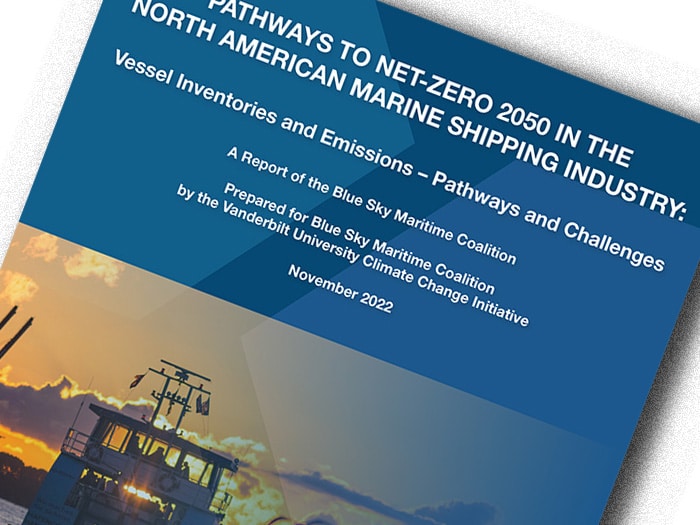
No “one size fits all” answer to decarbonizing North American maritime
Written by Nick Blenkey
Getting North American maritime to net-zero maritime will require the utilization of multiple fuels and propulsion systems.
The Blue Sky Maritime Coalition has released its second report in a series identifying pathways to accelerating the North American maritime industry’s transition to net-zero GHG emissions by 2050.
The report helps underscore the broad range of vessel sizes and types involved in North American waterborne transportation. And it also reveals that emissions associated with North American shipping are not required to be reported under a standardized structure and that different approaches are emerging as voluntary reporting has continued to increase.
.
“Developing recommendations to standardize accounting for GHG emissions within the North American shipping industry is essential in paving the way to net-zero emissions,” says Blue Sky Maritime Coalition president and CEO. David Cummins. “Distributing this data and making it easily accessible is an important step in expanding the drive to adopt these new technologies and ideas.”
With multiple vessel types and operating profiles, the report highlights how decarbonizing maritime will require the utilization of multiple fuels and propulsion systems, even within a single vessel category.
However, says the report, “despite some variation within each category, the majority of the vessels in each category share characteristics and operating conditions that are most relevant to the adoption of alternative fuels and propulsion systems.” One section of the report discusses, within each vessel category, the primary relevant characteristics and resulting fuels and propulsion systems likely to offer decarbonization potential.
Relevant to every vessel category, says the report, are fuels that can be used now, or with slight adaptations, in existing engines and fuel storage infrastructure in place of marine diesel. These include bio-fuels that could be true net-zero fuels if sourced and processed sustainably (that is, taking into account the full lifecycle of the feed-stock growth, harvesting, fuel production, and transport involved). If supplies were sufficient, many vessels could currently utilize biofuels.”
CONCLUSION
“Decarbonizing marine shipping will require utilization of multiple fuels and propulsion systems, even within a single vessel category, says the report in its conclusion. “Approaches that are currently viable on a fleet boat that operates in 12-hour shifts close to shore infrastructure may not be applicable to an ocean-going containership that must traverse thousands of miles before refueling. However … certain vessel categories are more or less suited to particular alternative fuels and propulsion systems based on vessel characteristics and operational requirements. Decarbonization potential within each vessel category will continue to expand as regulatory incentives drive adoption at scale of new and existing technologies, and pilot projects demonstrate commercial viability. We emphasize that for nearly all low- and no-carbon fuels, adoption is likely to require regulatory incentives, grants, and pilot projects to establish safety, realistic expectations of cost, and to demonstrate operational success applicable to each vessel category.
“A better understanding of emission profiles—both within vessel categories and for the marine shipping sector in North America more generally—is also needed to prioritize resource allocation to the vessels that present the greatest opportunity to reduce emissions. However, the lack of standardization in emissions inventory accounting presents a challenge and serves to decrease confidence in, and comparability between, reported values. Nevertheless, emission inventories are a critical step in achieving net zero, and are likely to improve as more consistent frameworks and approaches emerge.”




